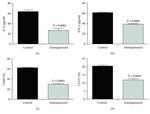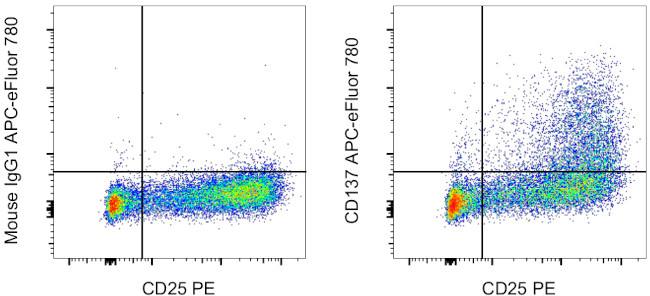Search Thermo Fisher Scientific
Invitrogen
CD137 (4-1BB) Monoclonal Antibody (4B4 (4B4-1)), APC-eFluor™ 780, eBioscience™
FIGURE: 1 / 3
CD137 (4-1BB) Antibody (47-1379-42) in Flow



Product Details
47-1379-42
Species Reactivity
Published species
Host/Isotype
Recommended Isotype Control
Class
Type
Clone
Conjugate
Excitation/Emission Max
Form
Concentration
Purification
Storage buffer
Contains
Storage conditions
Shipping conditions
RRID
Product Specific Information
Description: This 4B4 (4B4-1) monoclonal antibody reacts with human CD137 (also known as 4-1BB or TNFRSF9), which is an inducible member of the TNFR family of costimulatory molecules expressed on T cells, natural killer cells, dendritic cells, granulocytes, and mast cells. Involved in recruiting TNFR-associated factors (TRAF) 1 and 2, CD137 signaling plays a role in T cell activation, maintaining the survival of activated and CD8 memory T cells, as well as suppressing myelopoiesis and dendritic cell development. Stimulation of this receptor has also been shown to promote expansion of CD4+CD25+ T regulatory cells ex vivo. The ligand for CD137, 4-1BBL, is found on activated macrophages, mature B cells, hematopoietic stem cells, and myeloid progenitor cells.
Applications Reported: This 4B4 (4B4-1) antibody has been reported for use in flow cytometric analysis.
Applications Tested: This 4B4 (4B4-1) antibody has been pre-diluted and tested by flow cytometric analysis of stimulated normal human peripheral blood cells. This may be used at 5 µL (0.25 µg) per test. A test is defined as the amount (µg) of antibody that will stain a cell sample in a final volume of 100 µL. Cell number should be determined empirically but can range from 10^5 to 10^8 cells/test.
APC-eFluor 780 emits at 780 nm and is excited with the Red laser (633-647 nm). Please make sure that your instrument is capable of detecting this fluorochrome.
Light sensitivity: This tandem dye is sensitive to photo-induced oxidation. Please protect this vial and stained samples from light.
Fixation: Samples can be stored in IC Fixation Buffer (Product # 00-8222-49) (100 µL of cell sample + 100 µL of IC Fixation Buffer) or 1-step Fix/Lyse Solution (Product # 00-5333-57) for up to 3 days in the dark at 4°C with minimal impact on brightness and FRET efficiency/compensation. Some generalizations regarding fluorophore performance after fixation can be made, but clone specific performance should be determined empirically.
Excitation: 633-647 nm; Emission: 780 nm; Laser: Red Laser.
Target Information
CD137, also known as TNFRSF9 or 4-1BB, is an inducible costimulatory molecule expressed mainly on activated T cells. Its ligand, known as 4-1BBL, is expressed on activated macrophages, mature B cells, hematopoietic stem cells, and myeloid progenitor cells. CD137 signaling leads to maintaining the survival of activated T cells and CD8+ memory T cells, and clonal expansion of T cells, but also to suppressing myelopoiesis and dendritic cell development. Triggered CD137 induces a cytokine release profile regulating peripheral monocyte survival. Soluble forms of CD137 may provide negative control mechanism for some immune responses.
For Research Use Only. Not for use in diagnostic procedures. Not for resale without express authorization.
How to use the Panel Builder
Watch the video to learn how to use the Invitrogen Flow Cytometry Panel Builder to build your next flow cytometry panel in 5 easy steps.
Bioinformatics
Protein Aliases: 4 1 BB; 4-1BB ligand receptor; 41BB; CD137; CD137 antigen; CDw137; homolog of mouse 4-1BB; induced by lymphocyte activation (ILA); interleukin-activated receptor, homolog of mouse Ly63; receptor protein 4-1BB; s4 1 BB; s4 1BB; s41BB; sCD137; soluble 4 1 BB; soluble 4 1BB; soluble 41BB; soluble CD137; T cell antigen ILA; T-cell antigen 4-1BB homolog; T-cell antigen ILA; Tumor necrosis factor receptor superfamily member 9; tumor necrosis factor receptor superfamily, member 9
Gene Aliases: 4-1BB; CD137; CDw137; ILA; TNFRSF9
UniProt ID: (Human) Q07011
Entrez Gene ID: (Human) 3604

Performance Guarantee
If an Invitrogen™ antibody doesn't perform as described on our website or datasheet,we'll replace the product at no cost to you, or provide you with a credit for a future purchase.*
Learn more
We're here to help
Get expert recommendations for common problems or connect directly with an on staff expert for technical assistance related to applications, equipment and general product use.
Contact tech support

